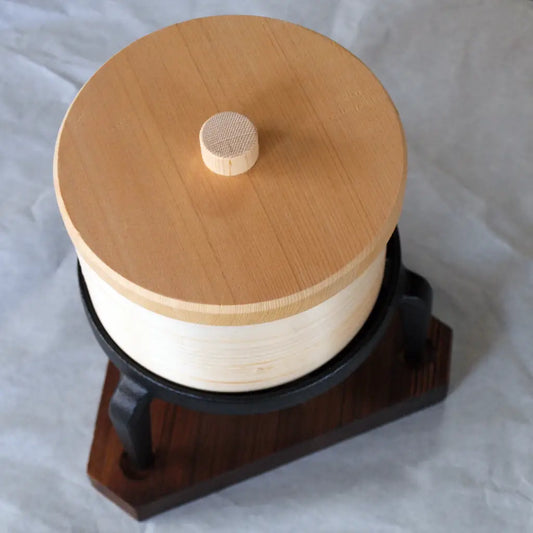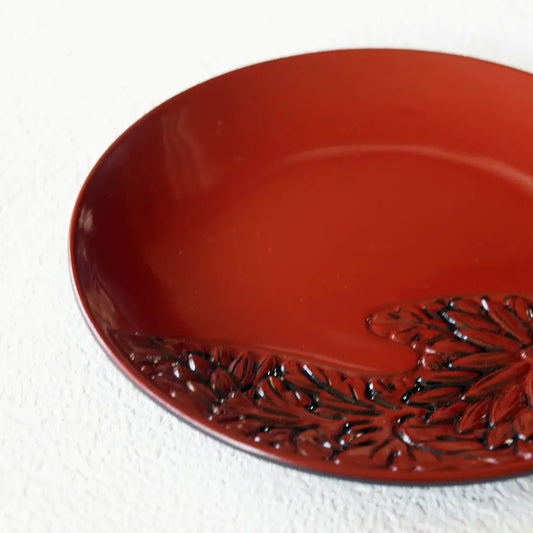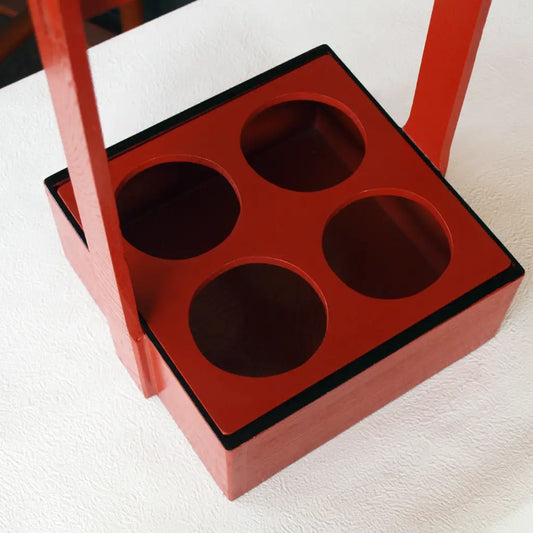Kiso Lacquerware - 400 Years of Tradition and Modern Beauty
Establishment of Kiso lacquerware
Local produce born from the local climate
The history of Kiso lacquerware dates back approximately 400 years. The region is blessed with abundant forest resources, excellent water quality, and a suitable climate, as well as durable base materials. In terms of technique, the region has evolved its designs to suit the times while respecting the essence of traditional handicrafts. These efforts have been recognized and the region has been designated as an important lacquerware center.
The area has also been recognized as a first-tier traditional industry production area, and has won numerous top awards at national lacquerware exhibitions, raising its profile. In the future, the entire region will continue to make efforts to take advantage of these characteristics and raise the profile of traditional arts and crafts.
About Kiso lacquerware
Lacquerware produced using a method originating from the Kiso region of Nagano Prefecture. The base is mainly made of cypress, with katsura and horse chestnut also commonly used. Blessed with an abundance of wood and a climate suitable for lacquerwork, lacquerware known as Hirasawa lacquerware or Fukushima lacquerware (Kiso Shunkei) has been actively produced since ancient times, especially in Hirasawa (formerly Hirasawa, Narakawa Village, now Kiso Hirasawa, Shiojiri City) and Fukushima. Hirasawa lacquerware began in the Keicho era (1596-1615), and it is said that there were over 10 manufacturers by the Shoo era (1652). Kiso Hirasawa - Lacquerware Town
In Kiso, which flourished as a post town on the Nakasendo road during the Edo period, lacquerware was a popular souvenir. In Narai-juku, the "Oroku comb," which originated in Yabuhara and was well-received by travelers, gained popularity by adding gorgeous lacquer ware.
Characteristics of Kiso lacquerware
1. Timber procurement
- Kiso lacquerware is made from wood, including the five Kiso trees and other ancient fine woods. The cold climate affects the trees in the Kiso region, causing changes in the growth and quality of the wood. An environment where suitable wood is easily available is ideal for the production of Kiso lacquerware.
- By the way, the five trees of Kiso are remembered as "Asahi Neko". A: Asunaro, Sa: Sawara, Hi: Hinoki, Ne: Nezuko, Ko: Koyamaki
2. Climate suitable for lacquerware production: Dry environment
- The Kiso region is at a high altitude, cool in the summer, snowy in the winter, and has a moderate humidity level for lacquer. These climatic conditions influence the production of Kiso lacquerware. The Narai River, which is a branch of the Shinano River and runs through the town, is also related to this air humidity.
- The Kiso Valley is an area with generally cold temperatures and high air humidity (suitable for lacquer) that is ideal for drying lacquer. This is because lacquer has the property of absorbing moisture from the air humidity and hardening during the process of drying and hardening (chemical reaction).
- < The chemical reaction that causes lacquer to harden > Lacquer does not dry by the typical evaporation of water. Instead, the enzyme "laccase" contained in lacquer is activated at a specific temperature and humidity (air humidity) and reacts with the surrounding oxygen, changing the lacquer from a liquid to a solid.
3. Discovery of Rust Soil
- During the Meiji period, rust soil was discovered in the Narai River basin, which when mixed with lacquer creates a very strong base. This made it possible to produce Kiso lacquerware using local materials, with a durability comparable to Wajima lacquerware.
- The locally produced "sabi-tsuchi" clay is a material so strong that when mixed with lacquer it is described as "unbreakable even against a blade." Taking advantage of this property, a wide variety of products are produced, from practical, durable everyday lacquerware to high-end lacquerware made using highly advanced techniques.
4. Passing on traditions and techniques
- The climate of the Kiso region has shaped the lifestyles and artisan traditions of the local community. The cold climate is a key factor in the production of some lacquerware, and the skills and knowledge in this region have been passed down from generation to generation.
- The combination of the climatic conditions and traditional techniques of these regions has resulted in the beautiful and durable lacquerware that is known for its quality. While the climate has influenced the products, it can also be said that unique techniques and processes have developed in response.

The old townscape of Urushigo Hirasawa: Looking from Nishiyama towards Higashiyama: The red tin roofs are atmospheric, and you can see Hirasawa Station and the Central West Line, National Route 19. Far across Higashiyama is the Yokokawa Valley in Tatsuno Town, famous for its snake stones.
The appeal of Kiso lacquerware
Traditional Japanese beauty and functional beauty that has been loved for generations
1. History and culture come alive
Kiso lacquerware is one of Japan's traditional crafts, and is imbued with centuries of history and artisanal techniques. Its history is long and unique, and it is known for its beautiful designs and advanced craftsmanship. Its carved lacquer and unique lacquer application methods (such as Kiso tsuishu) give it its own unique appeal.
Kiso lacquerware is not merely a decorative item, but is deeply rooted in Japan's food culture and lifestyle. Its durability and practicality have long made it a popular choice for everyday tableware. It is also highly regarded as a symbol of Japanese culture. While being a traditional Japanese craft, it also harmonizes with modern life. Its beauty and practicality are appealing to many people.
2. A variety of expressions created by unique techniques
The greatest feature of Kiso lacquerware is its diverse techniques.
- Kiso Shunkei Lacquer: Produced in 1975, lacquer is rubbed into the wood, creating a transparent finish that brings out the warmth and beautiful grain of the wood.
- Kiso Tsuishu: Unique patterns are created by grinding down multiple layers of lacquer.
- Colored lacquer: Geometric patterns are painted with colored lacquer and then polished to create a vivid, deep luster.
3. Lacquerware that fits into your daily life
Due to its durability and practicality, it has long been loved as tableware for everyday use. It is also highly functional, as it can be safely used to put hot things in it and can keep cold things cold. In recent years, its beautiful design has been reevaluated, and it is attracting attention as an item that harmonizes with modern lifestyles.
4. Outstanding technology and quality
Each piece is carefully crafted by artisans with many years of experience. From the selection of materials to the finishing touches, the craftsmanship and passion of these uncompromising artisans produce high-quality lacquerware.
5. Inheriting traditions and creating new value
While preserving tradition, we are always pursuing new possibilities. The future of Kiso lacquerware is limitless, with designs that meet modern needs and combinations with new materials.
6. Rich time and space
Living with lacquerware enriches your daily dining table and creates special moments. Its beautiful appearance gives warmth and quality to the space, leading to a richer life.
7. Great as a gift
Its beauty and practicality make it an ideal gift, and it will be appreciated in a variety of occasions, such as wedding gifts, housewarming gifts, and 60th birthday celebrations.
8. Experience the charm of Kiso lacquerware
There are many Kiso lacquerware workshops and galleries in the Kiso region, where you can actually touch the lacquerware and experience its beauty and the craftsmanship of the artisans.
9. Kiso Lacquerware: Passing on Japan's Traditional Crafts to the Future
Kiso lacquerware is a precious cultural heritage that conveys the beauty of traditional Japanese crafts. We aim to pass on this tradition to the future and create new value.
10. Information about Kiso lacquerware
-
Kiso Lacquerware Festival and Narai Post Town Festival : Every year on the first weekend of June. Annual lacquerware festival: Held throughout Hirasawa. Narai Post Town: Tea Pot Journey.
-
Roadside Station: Kiso Narakawa and Kiso Living Crafts Museum
Traditional crafts, Shiojiri wine, local sake, agricultural products, and the best of Shiojiri and Kiso all in one place -
Narai-juku
This is a post town located right in the middle of the Nakasendo road. The setting for "Ohisama," the raw beauty of Japan
Kiso Valley Japan Heritage: The original landscape of good old Japan

Snow scene in Kiso Hirasawa lacquer town

The climate of Kiso Hirasawa gave birth to Kiso lacquerware.

Kiso lacquerware and Shiojiri wine , how to choose lacquerware , comparison of lacquerware , characteristics and maintenance of lacquerware
It would be nice to have it! By collection [General lacquerware]
Featured collection
Large sale of stock
A harmony of beauty and history. Feel the breath of Japanese tradition in lacquerware from the storehouse.
Rare storehouse lacquerware will bring a touch of good old Japan to your space. We sell a wide range of products, from fascinating vessels and moisturizing lacquerware to easy-to-use and easy-to-handle synthetic resin products for commercial use. Products are taken out from the front of the storehouse, where you cannot go further inside, so you can look forward to what you find. Why not use them at home? It would be nice to have them❣ Enjoy looking for your favorite products.
-
Yudofu set/For one person/For disaster prevention/Camp/Cypress/With sawara lid/Stainless steel interior/Trivet/Dish/Base
Regular price ¥500 JPYRegular priceUnit price per -
Individual plates, wild chrysanthemum carvings, azuki beans on the inside, black on the outside, 4.5 inches, Showa retro
Regular price ¥300 JPYRegular priceUnit price per -
[Stylish] Wooden beer carrier, vermilion, with handle, Showa retro, can also be used as a flower vase
Regular price ¥2,500 JPYRegular priceUnit price per -
[Stylish] Wooden, beer carrier 2, with handle, Showa retro, can also be used as a flower vase
Regular price ¥2,000 JPYRegular priceUnit price per





